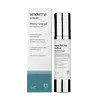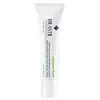What's inside
What's inside
 Key Ingredients
Key Ingredients

 Benefits
Benefits

 Concerns
Concerns

 Ingredients Side-by-side
Ingredients Side-by-side

Water
Skin ConditioningPropanediol
SolventPotassium Azeloyl Diglycinate
Skin ConditioningPropylene Glycol
HumectantPolysorbate 20
EmulsifyingTitanium Dioxide
Cosmetic ColorantLecithin
EmollientTriethanolamine
BufferingAmmonium Acryloyldimethyltaurate/Vp Copolymer
Alcohol
AntimicrobialAcrylamide/Sodium Acryloyldimethyltaurate Copolymer
Emulsion StabilisingAcrylates/C10-30 Alkyl Acrylate Crosspolymer
Emulsion StabilisingAzelaic Acid
BufferingBenzyl Salicylate
PerfumingC13-14 Isoparaffin
EmollientCetylpyridinium Chloride
AntimicrobialCichorium Intybus Root Extract
MaskingCitronellol
PerfumingEthylhexylglycerin
Skin ConditioningHydrochloric Acid
BufferingHydrogenated Lecithin
EmulsifyingLaureth-7
EmulsifyingLeptospermum Scoparium Branch/Leaf Oil
TonicLinalool
PerfumingMelaleuca Alternifolia Leaf Oil
AntioxidantMica
Cosmetic ColorantNiacin
SmoothingPanthenol
Skin ConditioningPantolactone
HumectantParfum
MaskingPhenoxyethanol
PreservativePhytosphingosine Hcl
Skin ConditioningPotassium Sorbate
PreservativeRetinal
Skin ConditioningRetinyl Palmitate
Skin ConditioningSilybum Marianum Extract
Skin ConditioningSodium Chloride
MaskingSodium Cholate
Skin ConditioningSodium Hyaluronate
HumectantSodium Hydroxide
BufferingTin Oxide
AbrasiveTocopherol
AntioxidantTranexamic Acid
AstringentTriticum Vulgare Germ Extract
Skin ConditioningWater, Propanediol, Potassium Azeloyl Diglycinate, Propylene Glycol, Polysorbate 20, Titanium Dioxide, Lecithin, Triethanolamine, Ammonium Acryloyldimethyltaurate/Vp Copolymer, Alcohol, Acrylamide/Sodium Acryloyldimethyltaurate Copolymer, Acrylates/C10-30 Alkyl Acrylate Crosspolymer, Azelaic Acid, Benzyl Salicylate, C13-14 Isoparaffin, Cetylpyridinium Chloride, Cichorium Intybus Root Extract, Citronellol, Ethylhexylglycerin, Hydrochloric Acid, Hydrogenated Lecithin, Laureth-7, Leptospermum Scoparium Branch/Leaf Oil, Linalool, Melaleuca Alternifolia Leaf Oil, Mica, Niacin, Panthenol, Pantolactone, Parfum, Phenoxyethanol, Phytosphingosine Hcl, Potassium Sorbate, Retinal, Retinyl Palmitate, Silybum Marianum Extract, Sodium Chloride, Sodium Cholate, Sodium Hyaluronate, Sodium Hydroxide, Tin Oxide, Tocopherol, Tranexamic Acid, Triticum Vulgare Germ Extract
Water
Skin ConditioningDibutyl Adipate
EmollientDimethicone
EmollientGlycerin
HumectantArachidyl Alcohol
EmollientBehenyl Alcohol
EmollientNiacinamide
SmoothingPanthenol
Skin ConditioningPolymethyl Methacrylate
Polyacrylate Crosspolymer-6
Emulsion StabilisingHelianthus Annuus Seed Oil
EmollientPotassium Azeloyl Diglycinate
Skin ConditioningTapioca Starch
Pseudoalteromonas Ferment Extract
HumectantArachidyl Glucoside
EmulsifyingSodium Salicylate
PreservativeTocopheryl Acetate
AntioxidantDipotassium Glycyrrhizate
HumectantXanthan Gum
EmulsifyingSodium Lauroyl Lactylate
EmulsifyingSodium Hyaluronate
HumectantCitric Acid
BufferingPolymethylsilsesquioxane
Ceramide NP
Skin ConditioningSodium Dna
Skin ConditioningCeramide AP
Skin ConditioningCeramide EOP
Skin ConditioningPhytosphingosine
Skin ConditioningCholesterol
EmollientCarbomer
Emulsion StabilisingTocopherol
AntioxidantPhenoxyethanol
PreservativeEthylhexylglycerin
Skin ConditioningDisodium EDTA
Parfum
MaskingWater, Dibutyl Adipate, Dimethicone, Glycerin, Arachidyl Alcohol, Behenyl Alcohol, Niacinamide, Panthenol, Polymethyl Methacrylate, Polyacrylate Crosspolymer-6, Helianthus Annuus Seed Oil, Potassium Azeloyl Diglycinate, Tapioca Starch, Pseudoalteromonas Ferment Extract, Arachidyl Glucoside, Sodium Salicylate, Tocopheryl Acetate, Dipotassium Glycyrrhizate, Xanthan Gum, Sodium Lauroyl Lactylate, Sodium Hyaluronate, Citric Acid, Polymethylsilsesquioxane, Ceramide NP, Sodium Dna, Ceramide AP, Ceramide EOP, Phytosphingosine, Cholesterol, Carbomer, Tocopherol, Phenoxyethanol, Ethylhexylglycerin, Disodium EDTA, Parfum
 Reviews
Reviews

Alternatives
Ingredients Explained
These ingredients are found in both products.
Ingredients higher up in an ingredient list are typically present in a larger amount.
Ethylhexylglycerin (we can't pronounce this either) is commonly used as a preservative and skin softener. It is derived from glyceryl.
You might see Ethylhexylglycerin often paired with other preservatives such as phenoxyethanol. Ethylhexylglycerin has been found to increase the effectiveness of these other preservatives.
Panthenol is a common ingredient that helps hydrate and soothe the skin. It is found naturally in our skin and hair.
There are two forms of panthenol: D and L.
D-panthenol is also known as dexpanthenol. Most cosmetics use dexpanthenol or a mixture of D and L-panthenol.
Panthenol is famous due to its ability to go deeper into the skin's layers. Using this ingredient has numerous pros (and no cons):
Like hyaluronic acid, panthenol is a humectant. Humectants are able to bind and hold large amounts of water to keep skin hydrated.
This ingredient works well for wound healing. It works by increasing tissue in the wound and helps close open wounds.
Once oxidized, panthenol converts to pantothenic acid. Panthothenic acid is found in all living cells.
This ingredient is also referred to as pro-vitamin B5.
Learn more about PanthenolParfum is a catch-all term for an ingredient or more that is used to give a scent to products.
Also called "fragrance", this ingredient can be a blend of hundreds of chemicals or plant oils. This means every product with "fragrance" or "parfum" in the ingredients list is a different mixture.
For instance, Habanolide is a proprietary trade name for a specific aroma chemical. When used as a fragrance ingredient in cosmetics, most aroma chemicals fall under the broad labeling category of “FRAGRANCE” or “PARFUM” according to EU and US regulations.
The term 'parfum' or 'fragrance' is not regulated in many countries. In many cases, it is up to the brand to define this term.
For instance, many brands choose to label themselves as "fragrance-free" because they are not using synthetic fragrances. However, their products may still contain ingredients such as essential oils that are considered a fragrance by INCI standards.
One example is Calendula flower extract. Calendula is an essential oil that still imparts a scent or 'fragrance'.
Depending on the blend, the ingredients in the mixture can cause allergies and sensitivities on the skin. Some ingredients that are known EU allergens include linalool and citronellol.
Parfum can also be used to mask or cover an unpleasant scent.
The bottom line is: not all fragrances/parfum/ingredients are created equally. If you are worried about fragrances, we recommend taking a closer look at an ingredient. And of course, we always recommend speaking with a professional.
Learn more about ParfumPhenoxyethanol is a preservative that has germicide, antimicrobial, and aromatic properties. Studies show that phenoxyethanol can prevent microbial growth. By itself, it has a scent that is similar to that of a rose.
It's often used in formulations along with Caprylyl Glycol to preserve the shelf life of products.
Potassium Azeloyl Diglycinate (PAD) comes from the condensation of azelaic acid mixed with glycine.
This ingredient has similar properties to azelaic acid; it can help reduce sebum production and soothe skin. PAD also inhibits tyrosinase activity to help brighten skin. Tyrosinase is an enzyme that controls melanin production.
A study from 2023 found 5% PAD combined with nicotinamide (a form of niacin) effectively reduced melanin production after 6 weeks.
Several studies from the 2010's also show PAD to be effective in alleviating symptoms of Rosacea.
Though this ingredient is considered a gentle active, higher amounts may result in irritation.
Unlike azelaic acid, this ingredient is water-soluble. This property makes it easier to formulate into skincare products.
Learn more about Potassium Azeloyl DiglycinateSodium Hyaluronate is hyaluronic acid's salt form. It is commonly derived from the sodium salt of hyaluronic acid.
Like hyaluronic acid, it is great at holding water and acts as a humectant. This makes it a great skin hydrating ingredient.
Sodium Hyaluronate is naturally occurring in our bodies and is mostly found in eye fluid and joints.
These are some other common types of Hyaluronic Acid:
Learn more about Sodium HyaluronateTocopherol (also known as Vitamin E) is a common antioxidant used to help protect the skin from free-radicals and strengthen the skin barrier. It's also fat soluble - this means our skin is great at absorbing it.
Vitamin E also helps keep your natural skin lipids healthy. Your lipid skin barrier naturally consists of lipids, ceramides, and fatty acids. Vitamin E offers extra protection for your skin’s lipid barrier, keeping your skin healthy and nourished.
Another benefit is a bit of UV protection. Vitamin E helps reduce the damage caused by UVB rays. (It should not replace your sunscreen). Combining it with Vitamin C can decrease sunburned cells and hyperpigmentation after UV exposure.
You might have noticed Vitamin E + C often paired together. This is because it is great at stabilizing Vitamin C. Using the two together helps increase the effectiveness of both ingredients.
There are often claims that Vitamin E can reduce/prevent scarring, but these claims haven't been confirmed by scientific research.
Learn more about TocopherolWater. It's the most common cosmetic ingredient of all. You'll usually see it at the top of ingredient lists, meaning that it makes up the largest part of the product.
So why is it so popular? Water most often acts as a solvent - this means that it helps dissolve other ingredients into the formulation.
You'll also recognize water as that liquid we all need to stay alive. If you see this, drink a glass of water. Stay hydrated!
Learn more about Water